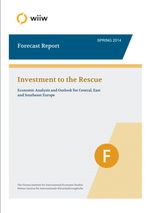Investment to the Rescue
Vasily Astrov, Rumen Dobrinsky, Vladimir Gligorov, Doris Hanzl-Weiss, Peter Havlik, Mario Holzner, Gabor Hunya, Michael Landesmann, Sebastian Leitner, Olga Pindyuk, Leon Podkaminer, Sandor Richter and Hermine Vidovic
wiiw Forecast Report No. Spring 2014, March 2014
132 pages including 27 Tables and 25 Figures
You can also download separate country reports of this report
| No. | Title | Author | |
|---|---|---|---|
| 1 | ALBANIA: INSTAT replay | Mario Holzner | Free Download |
| 2 | BOSNIA AND HERZEGOVINA: Getting rid of the straitjacket | Vladimir Gligorov | Free Download |
| 3 | BULGARIA: Economy seeking direction | Rumen Dobrinsky | Free Download |
| 4 | CROATIA: Economic recovery further delayed | Hermine Vidovic | Free Download |
| 5 | ESTONIA: Waiting for Scandinavian neighbours to revive | Sebastian Leitner | Free Download |
| 6 | HUNGARY: Moderate growth in 2013, moderate acceleration in 2014 | Sandor Richter | Free Download |
| 7 | KAZAKHSTAN: Consumption boom fuelled by credit to be over soon | Olga Pindyuk | Free Download |
| 8 | KOSOVO: Road to the New Kosovo | Mario Holzner | Free Download |
| 9 | LATVIA: Consumers in excellent mood | Sebastian Leitner | Free Download |
| 10 | LITHUANIA: Euro area within reach | Sebastian Leitner | Free Download |
| 11 | MACEDONIA: Steady improvement | Vladimir Gligorov | Free Download |
| 12 | MONTENEGRO: Slowly improving picture | Vladimir Gligorov | Free Download |
| 13 | POLAND: A sigh of relief | Leon Podkaminer | Free Download |
| 14 | ROMANIA: After export boom in 2013 recovery of consumption and investments expected | Gabor Hunya | Free Download |
| 15 | RUSSIAN FEDERATION: Stuck in transition! | Peter Havlik | Free Download |
| 16 | SERBIA: Early elections, then reforms | Vladimir Gligorov | Free Download |
| 17 | SLOVAKIA: Better growth prospects ahead | Doris Hanzl-Weiss | Free Download |
| 18 | SLOVENIA: Bailout avoided | Hermine Vidovic | Free Download |
| 19 | THE CZECH REPUBLIC: A change (for the better?) | Leon Podkaminer | Free Download |
| 20 | TURKEY: ‘Blowing in the wind’ of international capital flows | Michael Landesmann | Free Download |
| 21 | UKRAINE: Teetering on the brink | Vasily Astrov | Free Download |
The Vienna Institute for International Economic Studies (wiiw) expects GDP in Central, East and Southeast Europe (CESEE) to pick up speed and grow on average by 2-3% over the forecast period 2014-2016: a major driving force rooted in an upward reversal of public and private investment. The question remains, however, whether investment-led growth in the CESEE countries is merely a statistical base effect of a few replacement investments or an indication of a profound paradigmatic shift. Increasing evidence suggests the latter for a number of reasons.
During the ongoing economic crisis, public investment was severely reduced. However, in times of extreme uncertainty, the private sector is hesitant to invest. Hence, the public sector has to take the lead. It seems that the time for action has now come. This holds especially true for the New Member States, where towards the end of the previous year additional efforts were made to raise the absorption rate of the funds allocated within the context of the EU multiannual financial framework for 2007-2013 that was about to come to a close. Over the remaining disbursement period of the biennium 2014-2015 substantially higher amounts of EU-funded investment are to be expected. Given that, in practically all cases, national co-financing is also required, CESEE public capital investment will increase, with private investors likely following in its slipstream.
Apart from a number of transport infrastructure projects, a host of thermal power plant projects are in the pipeline, as are several major investments in the construction and expansion of nuclear power plants across the region. Apart from public and semi-public infrastructure investment initiatives that have the potential to spur subsequent private investment, improving growth prospects in the euro area, the CESEE economies’ main trading partner, are likely to encourage export industries in the region to modernise and increase their capital stock. This should help avert a lapse into a deflationary spiral and foster a shift towards better equilibrium with lower unemployment rates over the medium term.
However, substantial downward risks include possible effects from the current Russia-Ukraine conflict; in particular the interruption of energy supplies, potential trade embargoes or additional interest rate risk premia. All this could adversely affect investment-led growth in CESEE.
Reference to wiiw databases: wiiw Annual Database, wiiw Monthly Database
Keywords: Central and East European new EU Member States, Southeast Europe, financial crisis, Balkans, Russia, Ukraine, Kazakhstan, Turkey, economic forecasts, employment, foreign trade, competitiveness, debt, deleveraging, exchange rates, fiscal consolidation
JEL classification: C33, C50, E20, E29, F34, G01, G18, O52, O57, P24, P27, P33, P52
Countries covered: Albania, Bosnia and Herzegovina, Bulgaria, Central and East Europe, CIS, Croatia, Czechia, Estonia, European Union, Hungary, Kazakhstan, Kosovo, Latvia, Lithuania, North Macedonia, Montenegro, New EU Member States, Poland, Romania, Russia, Serbia, Slovakia, Slovenia, Southeast Europe, Turkey, Ukraine
Research Areas: Macroeconomic Analysis and Policy, Labour, Migration and Income Distribution, International Trade, Competitiveness and FDI
ISBN-13: 978-3-85209-037-5
Press Releases
Related Presentations
- Investment to the Rescue (press conference presentation in English)
- Investment to the Rescue (press conference presentation in German)
Related News
- New wiiw Forecast Report for Central, East and Southeast Europe: Investment to the Rescue
- wiiw Spring Seminar 2014 on growth strategy for Central and East Europe
- New wiiw forecast for Central, East and Southeast Europe: Investment to the Rescue
